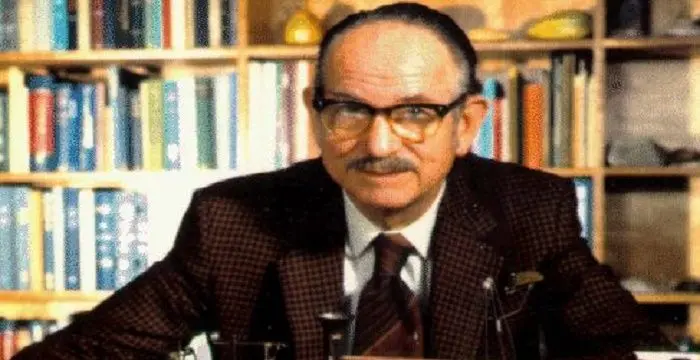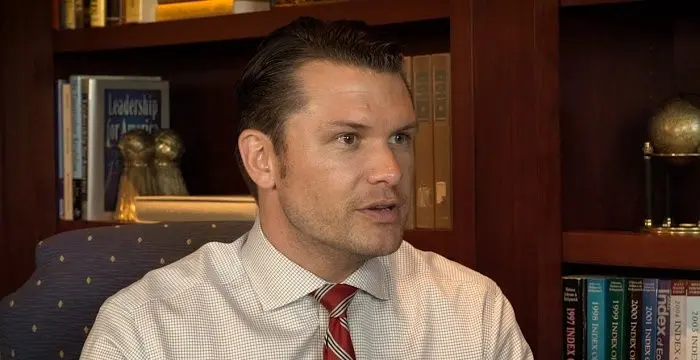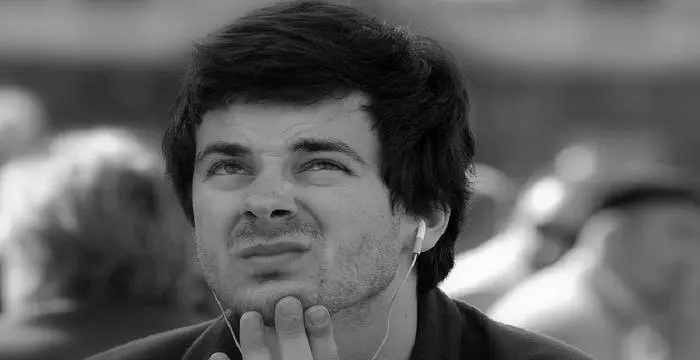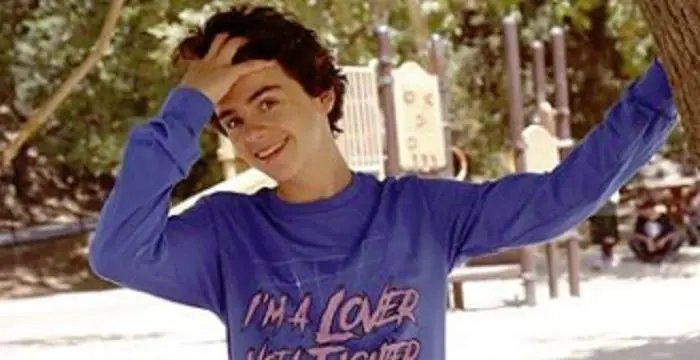
Edwin McMillan - Physicists, Birthday and Childhood
Edwin McMillan's Personal Details
Edwin Mattison McMillan was an American nuclear physicist who won the Nobel Prize in Chemistry in 1951
| Information | Detail |
|---|---|
| Birthday | September 18, 1907 |
| Died on | September 7, 1991 |
| Nationality | American |
| Famous | Princeton University, Scientists, Physicists |
| Spouses | Elsie Walford Blumer |
| Known as | Edwin Mattison McMillan |
| Childrens | Ann Bradford, David Mattison, Stephen Walker |
| Universities |
|
| Notable Alumnis |
|
| Birth Place | Redondo Beach, California |
| Gender | Male |
| Father | Dr. Edwin Harbaugh McMillan |
| Mother | Anne Marie Mattison |
| Sun Sign | Virgo |
| Born in | Redondo Beach, California |
| Famous as | Physicist |
| Died at Age | 83 |
// Famous Princeton University
Wentworth Miller
Wentworth Miller is an American actor and screenwriter who achieved recognition for his role in the TV series ‘Prison Break’.
Pete Hegseth
Pete Hegseth is a FOX News Channel contributor from America. Check out this biography to know about his childhood, family life, achievements and fun facts about him.
Terence Tao
Terence Tao is an Australian- American mathematician who has contributed enormously to the field of mathematics. Check out this biography to know about his childhood, family life and achievements.
Edwin McMillan's photo
Who is Edwin McMillan?
Edwin Mattison McMillan was an American nuclear physicist who won the Nobel Prize in Chemistry in 1951 for discovering the chemistry behind trans-uranium elements and ‘element 93’ also called ‘Neptunium’ which was heavier than uranium. He shared the prize with another nuclear physicist, Glenn T. Seaborg. The discovery of ‘Neptunium’ and other trans-uranium elements later provided a great source of nuclear energy and enhanced the study of nuclear theory and chemistry. He also discovered another trans-uranium element called ‘element 94’ or ‘Plutonium’ with help from Arthur C. Wahl, Joseph W. Kennedy and Glenn T. Seaborg. These discoveries could be announced only after the World War II due to reasons of national security. He was the first person to suggest the idea of ‘phase-stability’ which led to the development of the ‘synchroton’ and ‘syncro-cyclotron’ machines. These machines were later used to increase the energies of particles that were accelerated artificially in the machines by hundreds of MeV. The ‘cyclotron’ machine invented by Ernest Lawrence had reached its limit as the atomic particles accelerated in an ever-widening spiral could not attain a velocity beyond a certain point and went out of synchronization with respect to the electrical pulses. McMillan found out a way of maintaining the synchronization for indefinite speeds in a machine co-invented with Vladimir Veksler and named it ‘synchro-cyclotron’.
// Famous Scientists
Juliane Koepcke
Juliane Koepcke is a German-Peruvian biologist, who was the lone survivor among the 92 passengers and crew of the ill-fated LANSA Flight 508 that crashed in the Peruvian rainforest on 24 December 1971. Know more about her life in this biography.
Henry Cavendish
Henry Cavendish was a theoretical chemist and physicist, renowned for discovery of hydrogen and calculation of the mass of earth. To know more about his childhood, profile, timeline and career read on
Konstantin Tsiolkovsky
Konstantin Tsiolkovsky was a Russian rocket scientist and a pioneer of astronautics. This biography provides detailed information about his childhood, family, personal life, career, achievements, etc.
Childhood & Early Life
Edwin M. McMillan was born in Redondo Beach, California on September 18, 1907. His father, Dr. Edwin Harbaugh McMillan was a physician and his mother was Anne Marie Mattison. His parents were Scottish and hailed from the State of Maryland.
He had a younger sister named Catherine Helen.
His father-in-law was George Blumer, the dean of the medical school at Yale while his sister-in-law, Molly Blumer was married to Ernest Lawrence, namesake of the ‘Lawrence Berkeley National Laboratory’.
His family moved to Pasadena, California, from Maryland in October 1908 where he spent most of his childhood. He did his initial schooling at the ‘McKinley Elementary School’ from 1913 to 1918, at the ‘Grant School’ from 1918 to 1920 and then at the ‘Pasadena High School’ from where he graduated in 1924.
He did his B.Sc. in physics in 1928 from the ‘California Institute of Technology’ where he had done a research project with Linus Pauling.
He pursued his M.Sc. from the ‘California Institute of Technology’ in 1929 where did another research project ‘An improved method for the determination of the radium content of rocks’ which was not published.
He received his PhD in philosophy from the ‘Princeton University’ in 1933. The subject of his thesis for PhD was on the measurement of the magnetic moment of a proton in a molecular beam.
Career
In 1932, Edwin McMillan joined the University of California, Berkeley as a ‘National Research Fellow’ before completing his PhD and taught physics while he was there.
He started research work under Ernest O. Lawrence at the ‘Radiation Laboratory’ of the ‘University of California’ as a Staff Member at Berkeley in 1934. He helped to design cyclotrons and other equipment.
In 1935 he joined the faculty of the ‘Department of Physics’ at the ‘University of California’ at Berkeley as an instructor and became an Assistant Professor in 1936, and an Associate Professor in 1941.
In 1940 McMillan worked with Phillip Abelson to create a new element named ‘element 93’ which was the first trans-uranium element ever produced by bombarding Uranium-235 with neutrons and called it ‘Neptunium’.
In February 1941 he was helped by Joseph W. Kennedy, Glenn Seaborg and Arthur Wahl in isolating another trans-uranium element called ‘element 94’ which was named ‘Plutonium’ after McMillan’s practice of calling these elements by the names of planets.
During the Second World War he took leave from the university and worked at the ‘Radiation Laboratory’ at MIT on radar research and then moved to the ‘U. S. Navy Radio and Sound Laboratory’ in San Diego from 1941 to 1942 where he worked on sonar.
In November 1942 he moved to Los Alamos to carry out research on implosion for the ‘Manhattan Project’ which produced the first atomic bomb. He was there till 1945.
In 1945 McMillan suggested the idea of ‘phase stability’ which was used to develop the ‘synchroton’ and the ‘synchro-cyclotron’ afterwards.
He became a full professor in the faculty of the ‘University of California’ at Berkeley in 1946.
When the Second World War ended, he moved to the ‘Berkeley Radiation Laboratory’ of the ‘University of California’ which came to be known as the ‘Lawrence Berkeley National Laboratory’ later. He became the Associate Director of this laboratory in 1954 and later became the Deputy Director.
He served on the board of the ‘General Advisory Committee’ for the ‘Atomic Energy Commission’ from 1954 to 1958.
He became the Director of the ‘Lawrence Berkeley National Laboratory’ in 1958.
In 1960 he was appointed a member of the ‘Commission on High Energy Physics’ of the ‘International Union of Pure and Applied Physics’.
He was the chairman of the ‘National Academy of Sciences’ from 1968 to 1971.
He retired from the post of Director at the ‘Lawrence Berkeley National Laboratory’ in 1973.
From 1974 to 1975 he worked at CERN on the measurement of the magnetic moment of ‘muon’ after his retirement.
Major Works
Some of his publications include ‘Focusing in Linear Accelerators’ and ‘A Thick Target for Synchrotons and Betatrons’ that came out on August 24, 1950 and September 19, 1950 respectively.
His Nobel lecture ‘The Trans-uranium elements: Early History’ was published on December 12, 1951.
‘Notes on Quadruple Focusing’ was published in February 9, 1956 while ‘Some Thoughts on Stability in Non-linear Periodic Focusing systems’ came out on September 5, 1967 and its addendum was published on March 29, 1968.
Awards & Achievements
Edwin M. McMillan received the ‘Research Corporation Scientific Award’ in 1950.
In 1951 he was awarded the Nobel Prize for Chemistry.
He was awarded an honorary doctorate in science by the ‘Rensselaer Polytechnic Institute’ in 1961 and an honorary doctorate by the ‘Gustavus Adolphus College’ in 1863.
He received the ‘Atoms for Peace Award’ in 1963 along with Professor Vladimir I. Veksler.
He was a member of the ‘American Physical Society’, the ‘American Academy of Arts and Sciences’, the ‘National Academy of Sciences’ and the ‘American Philosophical Society’.
He received the ‘National Medal of Science’ in 1990.
Personal Life & Legacy
He married Elsie Walford Blumer on June 7, 1941.
He had one daughter, Ann Bradford and two sons, David Mattison and Stephen Walker from this marriage who were born in 1943, 1945 and 1949 respectively.
Edwin M. McMillan died on September 7, 1991 at El Cerrito, California, USA of complications arising due to diabetes.
Trivia
Edwin M. McMillan was very proud of his Scottish ancestry and was even made the president of the ‘Clan MacMillan Society of North America’ in 1958.
// Famous Physicists
Henry Cavendish
Henry Cavendish was a theoretical chemist and physicist, renowned for discovery of hydrogen and calculation of the mass of earth. To know more about his childhood, profile, timeline and career read on
Walter Kohn
Nobel Laureate Walter Kohn was an Austrian-born American theoretical chemist and physicist. Check out this biography to know about his childhood, life, achievements, works & timeline.
Nikola Tesla
Nikola Tesla was a Serbian-American inventor, best known for his development of alternating current electrical systems. This biography of Nikola Tesla provides detailed information about his childhood, life, achievements, works & timeline.
Edwin McMillan's awards
| Year | Name | Award |
|---|---|---|
Other | ||
| 0 | Nobel Prize in Chemistry (1951) | |
| 0 | Atoms for Peace Award (1963) | |
| 0 | National Medal of Science (1990) | |
Edwin McMillan biography timelines
- // 1029He pursued his M.Sc. from the ‘California Institute of Technology’ in 1929 where did another research project ‘An improved method for the determination of the radium content of rocks’ which was not published.
- // 1863 To 1961He was awarded an honorary doctorate in science by the ‘Rensselaer Polytechnic Institute’ in 1961 and an honorary doctorate by the ‘Gustavus Adolphus College’ in 1863.
- // 18th Sep 1907Edwin M. McMillan was born in Redondo Beach, California on September 18, 1907. His father, Dr. Edwin Harbaugh McMillan was a physician and his mother was Anne Marie Mattison. His parents were Scottish and hailed from the State of Maryland.
- // 1928He did his B.Sc. in physics in 1928 from the ‘California Institute of Technology’ where he had done a research project with Linus Pauling.
- // 1932In 1932, Edwin McMillan joined the University of California, Berkeley as a ‘National Research Fellow’ before completing his PhD and taught physics while he was there.
- // 1933He received his PhD in philosophy from the ‘Princeton University’ in 1933. The subject of his thesis for PhD was on the measurement of the magnetic moment of a proton in a molecular beam.
- // 1934He started research work under Ernest O. Lawrence at the ‘Radiation Laboratory’ of the ‘University of California’ as a Staff Member at Berkeley in 1934. He helped to design cyclotrons and other equipment.
- // 1940In 1940 McMillan worked with Phillip Abelson to create a new element named ‘element 93’ which was the first trans-uranium element ever produced by bombarding Uranium-235 with neutrons and called it ‘Neptunium’.
- // 1941 To 1942During the Second World War he took leave from the university and worked at the ‘Radiation Laboratory’ at MIT on radar research and then moved to the ‘U. S. Navy Radio and Sound Laboratory’ in San Diego from 1941 to 1942 where he worked on sonar.
- // Feb 1941In February 1941 he was helped by Joseph W. Kennedy, Glenn Seaborg and Arthur Wahl in isolating another trans-uranium element called ‘element 94’ which was named ‘Plutonium’ after McMillan’s practice of calling these elements by the names of planets.
- // 7th Jun 1941He married Elsie Walford Blumer on June 7, 1941.
- // Nov 1942 To 1945In November 1942 he moved to Los Alamos to carry out research on implosion for the ‘Manhattan Project’ which produced the first atomic bomb. He was there till 1945.
- // 1945In 1945 McMillan suggested the idea of ‘phase stability’ which was used to develop the ‘synchroton’ and the ‘synchro-cyclotron’ afterwards.
- // 1946He became a full professor in the faculty of the ‘University of California’ at Berkeley in 1946.
- // 1950Edwin M. McMillan received the ‘Research Corporation Scientific Award’ in 1950.
- // 19th Sep 1950Some of his publications include ‘Focusing in Linear Accelerators’ and ‘A Thick Target for Synchrotons and Betatrons’ that came out on August 24, 1950 and September 19, 1950 respectively.
- // 1951In 1951 he was awarded the Nobel Prize for Chemistry.
- // 12th Dec 1951His Nobel lecture ‘The Trans-uranium elements: Early History’ was published on December 12, 1951.
- // 1954When the Second World War ended, he moved to the ‘Berkeley Radiation Laboratory’ of the ‘University of California’ which came to be known as the ‘Lawrence Berkeley National Laboratory’ later. He became the Associate Director of this laboratory in 1954 and later became the Deputy Director.
- // 1954 To 1958He served on the board of the ‘General Advisory Committee’ for the ‘Atomic Energy Commission’ from 1954 to 1958.
- // 1958He became the Director of the ‘Lawrence Berkeley National Laboratory’ in 1958.
- // 1958Edwin M. McMillan was very proud of his Scottish ancestry and was even made the president of the ‘Clan MacMillan Society of North America’ in 1958.
- // 1960In 1960 he was appointed a member of the ‘Commission on High Energy Physics’ of the ‘International Union of Pure and Applied Physics’.
- // 1963He received the ‘Atoms for Peace Award’ in 1963 along with Professor Vladimir I. Veksler.
- // 1968 To 1971He was the chairman of the ‘National Academy of Sciences’ from 1968 to 1971.
- // 1973He retired from the post of Director at the ‘Lawrence Berkeley National Laboratory’ in 1973.
- // 1974 To 1975From 1974 to 1975 he worked at CERN on the measurement of the magnetic moment of ‘muon’ after his retirement.
- // 1990He received the ‘National Medal of Science’ in 1990.
- // 7th Sep 1991Edwin M. McMillan died on September 7, 1991 at El Cerrito, California, USA of complications arising due to diabetes.
// Famous Virgo Celebrities peoples
Temple Grandin
Temple Grandin is a well-known American writer, autistic activist and animal expert. This biography profiles her childhood, life, achievements, career and timeline
Alex Holtti
Check out all that you wanted to know about Alex Holtti, the famous Danish Viner & YouTuber; his birthday, his family and personal life, his girlfriends, fun trivia facts and more.
Benjamin Atkinson
Benjamin Atkinson is the son of the world-renowned British actor and comedian, Rowan Atkinson. Check out this biography to know about his childhood, family, personal life, including his age, birthday, etc.
Jack Dylan Grazer
Jack Dylan Grazer is an American actor known mainly for his performance in the movie version of ‘Stephen King’s novel ‘It.’ Check out this biography to know about his childhood, family, personal life, birthday, etc.
Ted Williams
Ted Williams was an American baseball player. Read this biography to learn more about his profile, childhood, life and timeline.
Mia Diaz
All about American dancer and actor Mia Diaz, including her age, family life, birthday, boyfriends, net worth, and some fun facts.
Edwin McMillan's FAQ
What is Edwin McMillan birthday?
Edwin McMillan was born at 1907-09-18
When was Edwin McMillan died?
Edwin McMillan was died at 1991-09-07
Where was Edwin McMillan died?
Edwin McMillan was died in El Cerrito, California
Which age was Edwin McMillan died?
Edwin McMillan was died at age 83
Where is Edwin McMillan's birth place?
Edwin McMillan was born in Redondo Beach, California
What is Edwin McMillan nationalities?
Edwin McMillan's nationalities is American
Who is Edwin McMillan spouses?
Edwin McMillan's spouses is Elsie Walford Blumer
Who is Edwin McMillan childrens?
Edwin McMillan's childrens is Ann Bradford, David Mattison, Stephen Walker
What was Edwin McMillan universities?
Edwin McMillan studied at Princeton University, California Institute of Technology, Princeton University
What was Edwin McMillan notable alumnis?
Edwin McMillan's notable alumnis is Princeton University
Who is Edwin McMillan's father?
Edwin McMillan's father is Dr. Edwin Harbaugh McMillan
Who is Edwin McMillan's mother?
Edwin McMillan's mother is Anne Marie Mattison
What is Edwin McMillan's sun sign?
Edwin McMillan is Virgo
How famous is Edwin McMillan?
Edwin McMillan is famouse as Physicist














